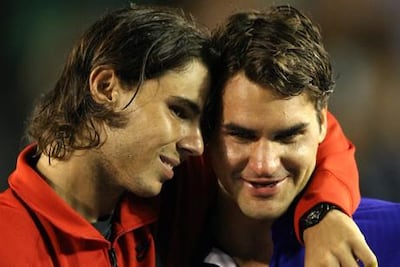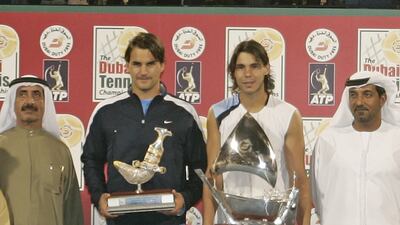It was an early chapter in tennis’ greatest rivalry and a victory that marked the first of Rafael Nadal’s many epic comebacks that would define his career.
On March 4, 2006, a packed stadium in Dubai witnessed a 19-year-old Nadal – “the kid from Mallorca” – win a first final against Roger Federer to claim the ATP Dubai Tennis Championships title, ending the Swiss’ three-year title reign and his 56-match unbeaten record on hard courts.
The two had only met three times before that final. Federer, then world No 1, was in top form after starting the season by winning the first Grand Slam of the year, the Australian Open.
Nadal, ranked No 2 in the world, was still navigating a return to fitness from a foot injury that had sidelined him for three months. During that time, he even contemplated quitting tennis and switching to golf, as he later revealed in a 2011 autobiography. “It was only his second tournament after recovery, we did not expect him to play at that level,” recalls veteran sports journalist Alaric Gomes who had covered the Dubai championships since 1996.
Federer took the early initiative, winning the first set 6-2. Things got worse in the second set when Nadal found himself a game down and 0-30.
But then, as he would go on to do so often in his career, Nadal summoned his gladiator spirit to turn the match around.
A series of decisive passing shots followed, his trademark fist pump celebration with a loud “Vamos" echoing around the stadium. He broke Federer to love to lead 5-4 and served out to level the match at one set apiece.
“He went for every shot, and the crowd got behind him – even though Federer was much loved in Dubai,” Gomes added. “The atmosphere was crazy.”
They went toe-to-toe in the third set until Nadal clinched the crucial break in the ninth game, eventually sealing victory 2-6, 6-4, 6-4.
“I was crying a little bit,” Nadal said afterwards. “This comeback is special for me. To beat Roger is special.”
“I think we are going to have a fantastic rivalry,” Federer remarked. And so they did.
Over the next two decades, their rivalry would become synonymous with tennis, inspiring millions around the world to pick up a racquet. The two faced off 40 times, with Nadal ultimately leading their head-to-head 26-14, including a 10-4 record in majors and 6-3 in Slam finals.
But it was their relationship off the court that has left an indelible mark.

There was the unforgettable moment at the 2009 Australian Open final when Nadal consoled a tearful Federer after a gruelling match, and the time they couldn’t stop laughing while filming a promo for an exhibition event – inevitably turned into a timeless meme – but the most powerful moment came at the 2022 Laver Cup in London, where Federer played the final match of his career with Nadal on the same side of the net.
“These are real human values that not only the two players but the whole tennis world can appreciate and be proud of,” says Gomes.
And as Nadal drew the curtain on his own illustrious career this week, 18 years on from that Dubai classic, Federer was not short of words.
“You beat me ... a lot. More than I managed to beat you, You made me reimagine my game. And you know what, Rafa? You made me enjoy the game even more,” Federer wrote.
It was a fitting tribute to his greatest rival, but most of all, a good friend.


